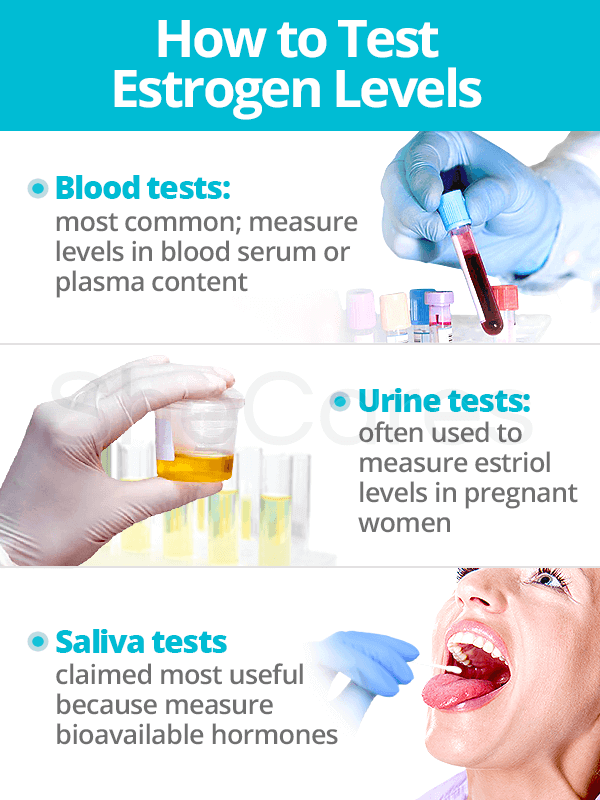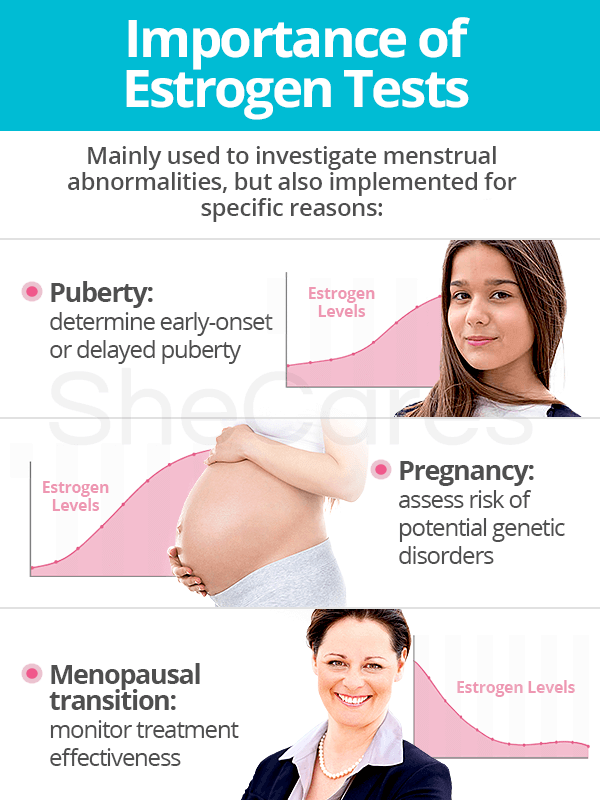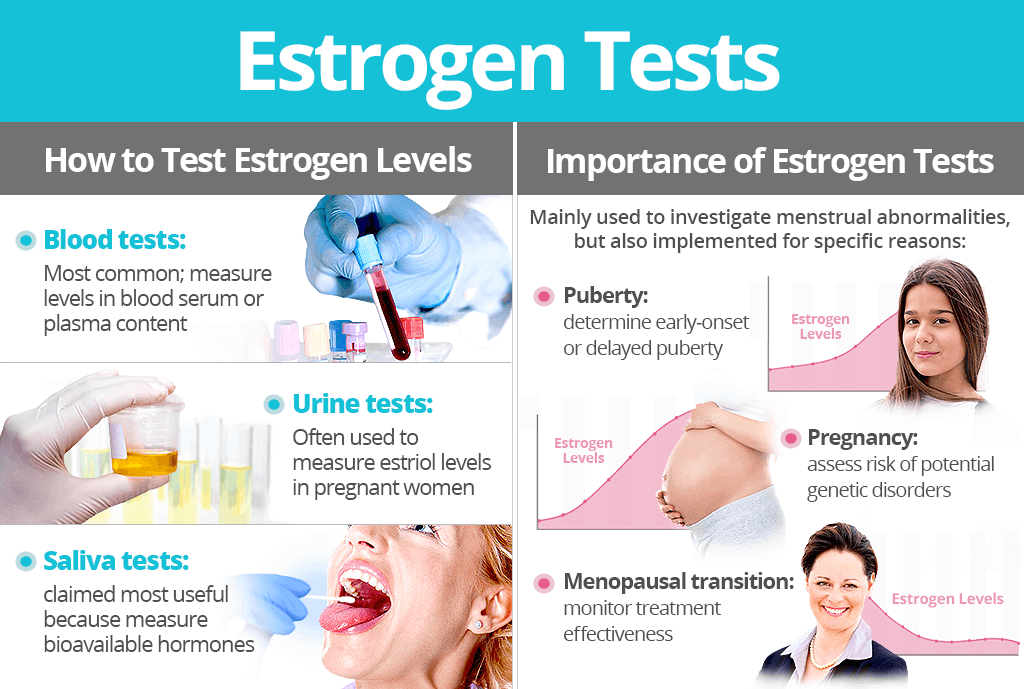Hormones which can be tested
- Estradiol
- Estriol
- Estrone
Estrogen tests are used to confirm a hormonal imbalance, which could be causing menstrual cycle irregularities, mood swings, hair loss, weight gain, and more. The hormones tested include estradiol, estriol, and estrone.
Continue reading to find out more about common and advanced estrogen tests as well as specific reasons why tests are important throughout life stages.
Common Estrogen Tests
Blood test

A blood test is the most conventional method of detecting hormone imbalance. It measures estradiol, estriol, and estrone levels found in blood serum or blood plasma content.
Depending on a woman's age, results may vary. Normal blood levels for estradiol (premenopausal) fluctuate between 30 to 400 pg/mL. Postmenopausal estradiol normally measures up to 30 pg/mL.
Due to the variations in estradiol levels during each menstrual cycle, it is suggested that samples be taken during the early follicular phase (Days 1 - 3 in a 28-day cycle) or during the luteal phase peak (Days 20 - 21 in a 28-day cycle).
This will eliminate any major fluxes in estrogen levels which may occur at other times, such as during ovulation. Also, abnormal hormone levels will be clearly separated.
For pregnant women, a rise in estriol begins at 6 - 10 weeks of gestation when fetal adrenal gland secretion of estrogen begins. Therefore, maternal blood levels are measured during the 15th to 20th week since conception.
Moreover, concentrations will plateau at 31 - 35 weeks only to increase again at 35 - 36 weeks. Results vary from woman to woman, but normal estriol ranges fluctuate between 31 to 460 ng/mL at term.
Urine test
Unlike blood tests, urine tests are most commonly only used to measure the level of estriol in pregnant women.
Furthermore, urine tests should be taken the same time as blood tests during a woman's cycle in order to avoid major fluctuations in the results.
However, many scientists believe that using a urine test is not completely conclusive because they measure hormone metabolites - or byproducts - that have been excreted, not bioavailable hormones that directly affect the body.
Hormone levels in urine can also be affected by variables such as diet, kidney function, drug use, etc.
Advanced Estrogen Tests
Saliva test
Many researchers argue that saliva tests are more useful because they measure bioavailable hormones delivered to bodily receptors. This distinction is important when monitoring estrogen fluctuations during topical hormone therapies, such as HRT.
Urine tests also assess hormonal risk factors for diseases that are hormone dependent, such as breast or uterine cancer.
Just as with blood and urine tests, estrogen levels measured with saliva tests should fall within aforementioned ranges.
However, critics point out that saliva tests are more affected by environmental factors, such as eating, drinking, smoking, or taking certain medications like contraceptive pills. Thus, these tests are sometimes deemed less reliable.
Nonetheless, saliva tests are popular for those who wish to self-test from home. It is recommended to discuss results from these self-administered tests with a doctor to confirm a hormonal imbalance and identify any medical conditions.
Why are Estrogen Tests Important?

Throughout life, estrogen tests are used to help investigate menstrual abnormalities, such as unusual vaginal bleeding, infertility, and amenorrhea. However, they are implemented for specific reasons as well.
During puberty, estradiol tests help determine why a girl develops secondary sex characteristics sooner or later than expected, known as early-onset puberty and delayed puberty, respectively.
During pregnancy, an estriol test assesses the probability of potential genetic disorders. Decreased levels have been associated with conditions such as Down syndrome, neural tube defects, and adrenal abnormalities.
These blood tests are recommended for women with a family history of birth defects; are 35 and older; have used possibly harmful medications or drugs; or had a viral infection during pregnancy.
During the menopausal transition, an estrone test is often performed after experiencing symptoms of menopause, including hot flashes, night sweats, insomnia, and irregular periods. When undergoing HRT, estrone tests may be ordered to help monitor treatment effectiveness.
Now that the most common estrogen tests have been explained, continue reading to find out about different estrogen levels and what they mean.
Sources
- American Association for Clinical Chemistry. (2014). Estrogens. Retrieved July 31, 2017, from https://labtestsonline.org/understanding/analytes/estrogen/tab/test/
- American Pregnancy Association. (2016). Triple Screen Test. Retrieved July 21, 2017, from http://americanpregnancy.org/prenatal-testing/triple-screen-test/
- National Institute of Health. (2015). Estradiol blood test. Retrieved July 12, 2017, from https://medlineplus.gov/ency/article/003711.htm
- PubChem: Open Chemistry Database. (n.d.). Estriol. Retrieved July 21, 2017, from https://pubchem.ncbi.nlm.nih.gov/compound/estriol#section=Top
- Society for Endocrinology. (n.d.). Laboratory tests. Retrieved July 21, 2017, from http://www.yourhormones.info/practical-information/laboratory-tests/
- Speroff, L. & Fritz, M.A. (2005). Clinical Gynecologic Endocrinology and Infertility. Pennsylvania: Lippincott Williams & Wilkins. Available from Google Books.
- U.S. National Library of Medicine. (2017). Estradiol blood test. Retrieved July 31, 2017, from https://medlineplus.gov/ency/article/003711.htm
- Women in Balance Institute: National University of Natural Medicine. (2017). Hormone Testing & Diagnostic Resources | Unraveling the Mystery of Hormone Testing. Retrieved July 31, 2017, from https://womeninbalance.org/physician-resources/hormone-testing-diagnostic-resources/ | https://womeninbalance.org/2012/10/26/unraveling-the-mystery-of-hormone-testing/
